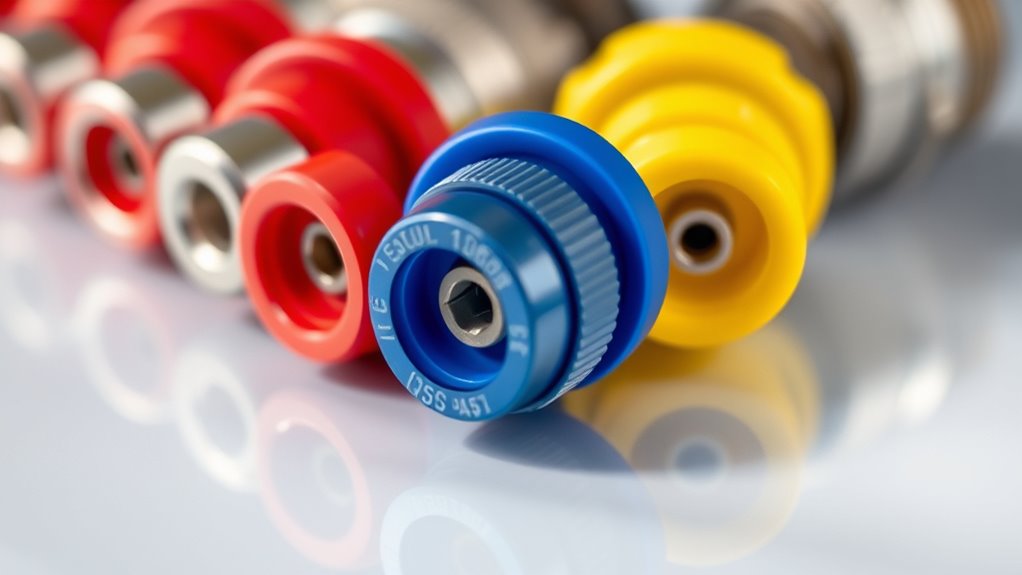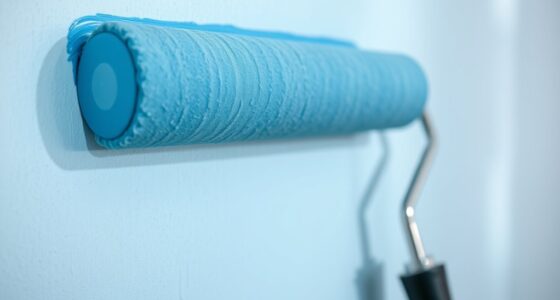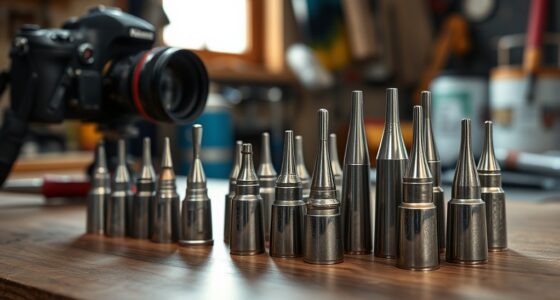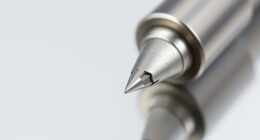Understanding spray tip numbers and colors helps you choose the right airless sprayer tips for your project. The numbers indicate the orifice size and spray width, affecting paint flow and coverage, while color codes quickly identify tip types for specific tasks. Wider patterns cover large areas fast, while narrower ones allow precision. Getting familiar with these details will make your spraying more efficient and professional-looking—keep exploring to master selecting the best tips for your needs.
Key Takeaways
- Tip colors indicate spray pattern width and purpose, simplifying quick selection for different projects.
- Numbers on tips represent orifice size and spray fan width, guiding appropriate application based on surface needs.
- Larger fan widths (e.g., 12, 15 inches) cover big surfaces quickly, while narrower tips (e.g., 517) provide detailed control.
- Correct tip selection improves finish quality, reduces overspray, and enhances spraying efficiency.
- Using reputable tips and understanding color and number codes ensure optimal results and longer tip lifespan.
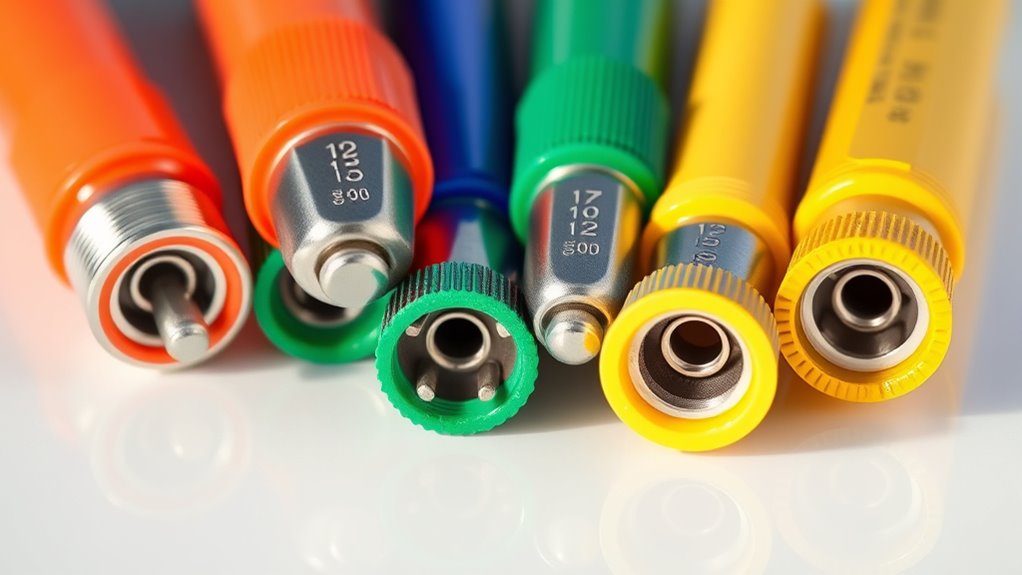
Using the right tips on your airless sprayer can substantially improve your painting results. When selecting tips, understanding how tip selection influences the spray pattern is essential for achieving a smooth, even finish. The tip determines the shape and size of the spray, which directly affects coverage, detail, and overall quality of your job. Before starting, consider the surface you’re working on and the type of paint you’re using. Different tips are designed for specific tasks, so choosing the right one can save you time and prevent frustration.
Choosing the right airless sprayer tips enhances coverage, finish quality, and efficiency.
The spray pattern, which is shaped by your tip choice, plays a vital role in your painting efficiency. Tips are often categorized by their spray fan width and orifice size, usually indicated by numbers and colors. The first number typically represents the spray fan width in inches, such as 10, 12, or 15 inches. A wider pattern covers more area quickly, making it ideal for large, flat surfaces like walls or ceilings. Conversely, a narrower pattern, like 8 inches, offers more control for detailed or intricate work. The second number indicates the orifice size, which impacts the volume of paint delivered. Larger orifice sizes are suitable for thicker paints or applying a thicker coat, while smaller sizes work better with thinner paints or for fine finishing.
Color coding on tips helps you quickly identify the right spray pattern. For example, a red tip may indicate a 517 tip with a 0.517-inch orifice, designed for heavy-duty tasks or thick coatings. Blue tips might be for general-purpose spraying, while green or yellow tips often serve specific functions like fine finishing or detailed work. Familiarizing yourself with these colors simplifies the tip selection process, ensuring you pick the right one for your project.
Additionally, understanding vetted product information can help you select high-quality tips that perform reliably and last longer, optimizing your painting experience. Adjusting the tip and spray pattern to match your project needs can considerably improve your results. If you’re covering large surfaces, opt for a wider fan pattern to increase speed and efficiency. When working on detailed trim or corners, a narrower pattern provides better control. Remember, the tip’s size and spray pattern influence not just coverage but also the quality of the finish. Overly wide patterns can cause overspray and drips, while too narrow patterns might require multiple passes, increasing your project time.
Frequently Asked Questions
How Do I Choose the Right Tip for Different Coatings?
When choosing the right tip for different coatings, you need to consider coating compatibility and sprayer maintenance. Match the tip size to the coating’s viscosity—thicker coatings require larger tips for proper flow. Check the manufacturer’s recommendations to prevent clogs and ensure a smooth application. Regular sprayer maintenance helps keep tips clean, which ensures consistent results and prevents damage. Always select tips suited for your specific coating type for the best finish.
Can Tips Be Used Interchangeably Between Brands?
Like fitting a key into a lock, using tips interchangeably between brands isn’t always seamless. Tip materials and spray pattern compatibility matter; some tips are designed for specific brands’ spray guns and may not fit or perform well elsewhere. Always check if the nozzle thread and spray pattern match your sprayer’s requirements. Mixing brands without verifying can lead to uneven coating and equipment damage, so it’s best to stick with recommendations.
How Often Should I Replace Airless Sprayer Tips?
You should replace your airless sprayer tips when you notice reduced spray quality, such as uneven coating or clogging, which affects your tip’s longevity. Regular maintenance tips, like cleaning after each use, help extend its life. Typically, change tips every few projects or when wear becomes evident. Proper care guarantees consistent performance, saving you time and money, and keeps your projects looking professional.
What Safety Precautions Are Necessary When Using Different Tips?
When using different tips, you need to prioritize safety. Always wear appropriate personal protective equipment like gloves, goggles, and a mask to protect against spray particles. Follow proper tip cleaning techniques after each use to prevent clogs and guarantee safe operation. Be cautious of high pressure, and never point the sprayer at yourself or others. Taking these precautions keeps you safe and maintains your equipment’s performance.
Are There Tips Specifically Designed for Detailed or Delicate Work?
Did you know that using the right tip can improve your painting efficiency by up to 30%? For detailed or delicate work, you should choose precision tips designed specifically for delicate coatings. These tips feature smaller or finer spray patterns, allowing you to control paint flow and achieve smooth, flawless finishes. By selecting the correct precision tip, you make your work easier and guarantee the highest quality results on intricate surfaces.
Conclusion
Understanding airless sprayer tips can substantially improve your painting results. Did you know that using the right tip can increase your spraying efficiency by up to 30%? By matching tip size and color to your project, you save time, reduce waste, and achieve a smoother finish. So, next time you pick your sprayer tip, remember that the right choice isn’t just about color or number—it’s about getting the job done faster and better.
Franz came aboard the Paint Sprayer Zone team with a background in both journalism and home renovation. His articulate writing style, combined with a passion for DIY projects, makes him an invaluable asset. Franz has a knack for breaking down technical jargon into easy-to-understand content, ensuring that even the most novice of readers can grasp the complexities of paint sprayers.
